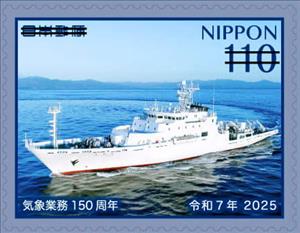Stamp: Ryofumaru (marine weather observation vessel) (Japan 2025)
Ryofumaru (marine weather observation vessel) (Japan 2025)
28 May (Japan ) within release Japan Meteorological Agency, 150 Years (2025) goes into circulation Stamp Ryofumaru (marine weather observation vessel) face value 110 Japanese yen
| Stamp Ryofumaru (marine weather observation vessel) in catalogues | |
|---|---|
| Colnect codes: | Col: JP 2025.05.28-01j |
Stamp is horizontal format.
stamp from mini-sheetAlso in the issue Japan Meteorological Agency, 150 Years (2025):
- Stamp - First image of Himawari No. 9 face value 110;
- Stamp - First supercomputer face value 110;
- Stamp - Image of Wiechert seismometer and seismic waveform face value 110;
- Mini Sheet - Japan Meteorological Agency, 150 Years face value 10*110;
- Stamp - Mobile observation of volcanoes face value 110;
- Stamp - Motoemachi Period Government Building and Outdoor Hall face value 110;
- Stamp - NAPS11 (supercomputer) face value 110;
- Stamp - Ryofumaru (marine weather observation vessel) face value 110;
- Stamp - Satellite image of June 1, 2016 face value 110;
- Stamp - Toranomon Office Building and front entrance plate face value 110;
- Stamp - Weather map for June 1, 2016 face value 110;
Stamp Ryofumaru (marine weather observation vessel) it reflects the thematic directions:
Meteorology is a branch of the atmospheric sciences (which include atmospheric chemistry and physics) with a major focus on weather forecasting. The study of meteorology dates back millennia, though significant progress in meteorology did not begin until the 18th century. The 19th century saw modest progress in the field after weather observation networks were formed across broad regions. Prior attempts at prediction of weather depended on historical data. It was not until after the elucidation of the laws of physics, and more particularly in the latter half of the 20th century, the development of the computer (allowing for the automated solution of a great many modelling equations) that significant breakthroughs in weather forecasting were achieved. An important branch of weather forecasting is marine weather forecasting as it relates to maritime and coastal safety, in which weather effects also include atmospheric interactions with large bodies of water.
A ship is a large watercraft that travels the world's oceans and other sufficiently deep waterways, carrying passengers or goods, or in support of specialized missions, such as defense, research and fishing. Historically, a "ship" was a sailing vessel with at least three square-rigged masts and a full bowsprit. Ships are generally distinguished from boats, based on size, shape and load capacity.


